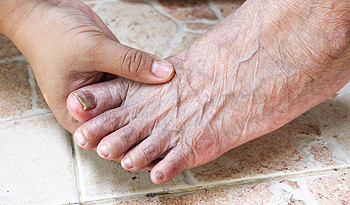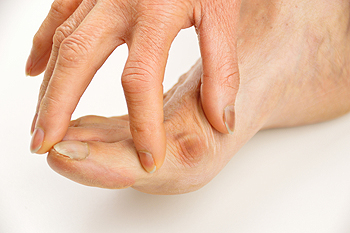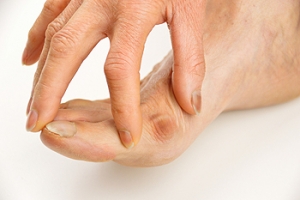Connect With Us
Blog

Did I Sprain My Ankle?
 An ankle sprain is one of the most common sports injuries that can occur. Ankle sprains take place when the ligaments that support the ankle are twisted or stretched too far and ultimately tear. The severity of the injury is determined by the amount of ligament damage at the time of injury. Common signs of a sprained ankle include swelling, tenderness, bruising, skin discoloration, pain, stiffness, and being unable to put weight on the affected ankle. Because a more severe sprain can weaken the ankle and lead to future sprains, it is important to visit a podiatrist who can help diagnose and treat your injury. Common treatments may include an ankle brace, rest, ice and physical therapy.
An ankle sprain is one of the most common sports injuries that can occur. Ankle sprains take place when the ligaments that support the ankle are twisted or stretched too far and ultimately tear. The severity of the injury is determined by the amount of ligament damage at the time of injury. Common signs of a sprained ankle include swelling, tenderness, bruising, skin discoloration, pain, stiffness, and being unable to put weight on the affected ankle. Because a more severe sprain can weaken the ankle and lead to future sprains, it is important to visit a podiatrist who can help diagnose and treat your injury. Common treatments may include an ankle brace, rest, ice and physical therapy.
Although ankle sprains are common, they aren’t always minor injuries. If you need your ankle injury looked at, contact one of our podiatrists from Family Foot Care of Long Island. Our doctors can provide the care you need to keep you pain-free and on your feet.
How Does an Ankle Sprain Occur?
Ankle sprains are the result of a tear in the ligaments within the ankle. These injuries may happen when you make a rapid shifting movement while your foot is planted. A less common way to sprain your ankle is when your ankle rolls inward while your foot turns outward.
What Are the Symptoms?
- Pain at the sight of the tear
- Bruising/Swelling
- Ankle area is tender to touch
- In severe cases, may hear/feel something tear
- Skin discoloration
Preventing a Sprain
- Wearing appropriate shoes for the occasion
- Stretching before exercises and sports
- Knowing your limits
Treatment of a Sprain
In many cases, the RICE method (Rest, Ice, Compression, and Elevate) is used to treat ankle sprains. However, you should see a podiatrist to see which treatment option would work best with your injury. In severe cases, surgery may be required.
It is important to ask your doctor about rehab options after you receive treatment for your injury. Stretching, strength training, and balance exercises may help the ankle heal while also preventing further injury.
If you have any questions, please feel free to contact our office located in Port Jefferson Station, NY . We offer the newest diagnostic and treatment technologies for all your foot care needs.
Ankle Sprains
Although ankle sprains may not be as serious as a broken ankle, they should be given immediate attention and care. An ankle sprain can lead to a significant amount of pain, as well as limited mobility. They are often characterized by the swelling and discoloration of the skin. This occurs when the ligaments are stretched beyond their limits.
The simple act of walking can sometimes cause a sprain, which makes ankle sprains a very common injury that can happen to anyone. They occur when the ankle twists in an awkward way or rolls over itself, causing a pop or snap in the tendons around the ankle. Some people are more at risk than others. These include athletes who continually push their bodies to the limits and also people who have previously suffered accidents to the feet, ankles, or lower legs.
Most of the time, an ankle sprain is not severe enough for hospital attention. There are many at-home treatment options available, including propping the leg up above your head to reduce blood flow and inflammation, applying ice packs to the affected area as needed, taking over-the-counter pain relievers and anti-inflammatory medication, using an ACE bandage to wrap and support the injured ankle, and most importantly, remaining off your feet until the ankle has fully healed.
Despite this, an ankle sprain can turn into a severe injury that might require hospitalization. If the ankle ligaments or muscles are damaged from a tear or rip, that is one sign that the sprain is severe enough for hospital attention and possibly for surgery. Even after the surgery, the recovery process can be long. You may need to have rehabilitation sessions administered by your podiatrist to get your ankle back to full health.
The severity of your sprain might become apparent if you are unable to stand or walk, consistent pain occurs over a prolonged period of time, swelling is much more severe than initially present, or if you start to experience tingling or numbness. These signs may indicate that your ankle sprain might actually be a broken ankle, an injury that requires immediate medical attention.
Although they are not completely avoidable, ankle sprains can be curbed with some preventative treatment measures. These include wearing appropriate-fitting shoes that not only provide a comfortable fit, but also ankle support. It is also recommended to stretch before doing any kind of physical activity, as this will help lower your body’s chance for an injury.
Foot Problem Prevention for Elders
 Foot ailments can become more common as we age. To decrease the likelihood of developing various foot problems, it is important to take care of your feet. Wearing the right shoes is of the utmost importance. Shoes that are too tight can increase the risk of foot pain, hammertoes, bunions, and blisters, while shoes that are too loose can lead to a fall. It is recommended that you wear comfortable, properly fitted shoes that give your toes room to move. Keeping your feet well-moisturized can prevent corns and calluses, while cutting your toenails regularly can prevent ingrown nails. Another thing that you can do to benefit your feet is to stretch them. Flex and wiggle your toes and walk regularly to help maintain foot strength and flexibility. If you develop foot problems, it is recommended that you see a podiatrist, who can diagnose and treat your condition.
Foot ailments can become more common as we age. To decrease the likelihood of developing various foot problems, it is important to take care of your feet. Wearing the right shoes is of the utmost importance. Shoes that are too tight can increase the risk of foot pain, hammertoes, bunions, and blisters, while shoes that are too loose can lead to a fall. It is recommended that you wear comfortable, properly fitted shoes that give your toes room to move. Keeping your feet well-moisturized can prevent corns and calluses, while cutting your toenails regularly can prevent ingrown nails. Another thing that you can do to benefit your feet is to stretch them. Flex and wiggle your toes and walk regularly to help maintain foot strength and flexibility. If you develop foot problems, it is recommended that you see a podiatrist, who can diagnose and treat your condition.
Proper foot care is something many older adults forget to consider. If you have any concerns about your feet and ankles, contact one of our podiatrists from Family Foot Care of Long Island. Our doctors can provide the care you need to keep you pain-free and on your feet.
The Elderly and Their Feet
As we age we start to notice many changes in our body, but the elder population may not notice them right away. Medical conditions may prevent the elderly to take notice of their foot health right away. Poor vision is a lead contributor to not taking action for the elderly.
Common Conditions
- Neuropathy – can reduce feeling in the feet and can hide many life-threatening medical conditions.
- Reduced flexibility – prevents the ability of proper toenail trimming, and foot cleaning. If left untreated, it may lead to further medical issues.
- Foot sores – amongst the older population can be serious before they are discovered. Some of the problematic conditions they may face are:
- Gouging toenails affecting nearby toe
- Shoes that don’t fit properly
- Pressure sores
- Loss of circulation in legs & feet
- Edema & swelling of feet and ankles
Susceptible Infections
Diabetes and poor circulation can cause general loss of sensitivity over the years, turning a simple cut into a serious issue.
If you have any questions please feel free to contact our office located in Port Jefferson Station, NY . We offer the newest diagnostic and treatment technologies for all your foot and ankle needs.
Elderly Foot Care
As you grow older, you will start to notice more problems with your feet due to wear and tear. This may also happen because the skin will start to become thin and lose elasticity. Some signs of aging feet are regular aches and pains, bunion development, and clawed toes.
Fortunately, there are ways you can improve comfort, relieve pain, and maintain mobility in your feet. One of the best ways to deal with aging feet is to exercise. If you keep active, your muscles will become toned which will then strengthen the arches in the foot and stimulate blood circulation.
It is important that you practice proper foot care to protect your aging feet. You should wash your feet in warm water on an everyday basis. Afterward, the feet need to be dried well and it is important to dry between the toes. Your toenails should be trimmed and kept under control; nails that are poorly cut may become ingrown. At the end of each day, performing an inspection of your feet will allow you to detect any ailments in their early stages.
As you grow older, it becomes more important that you wear comfortable shoes. Your shoes should be secure, and they should provide decent arch support. If you are looking to buy a new pair of shoes, it is best to look for a pair that are made from a breathable material. It is also helpful to have shoes that have a bit of extra room at the top of the shoe, especially if you suffer from swollen feet.
The most common foot problems that elderly people will encounter are bunions, calluses, corns, hammertoes, heel pain, and foot problems related to diabetes. Some other issues include arch pain, tarsal tunnel syndrome, Achilles tendonitis, and Morton’s neuroma
An annual foot examination is a great way for you to ensure that you do not have any serious health problems with your feet. You should talk to a podiatrist about the available treatment options for whichever foot issue you are dealing with.
Do I Need Foot Surgery?
 Patients who consider having foot surgery performed have often exhausted other means of obtaining relief. It is considered to be a last resort for finding permanent relief, and many patients are willing to go through the recommended recovery time. One of the more common types of foot surgeries is having a bunion removed. A bunion is a bony protrusion that forms at the bottom of the big toe. It is often uncomfortable to wear shoes, and surgery may be a viable option for relief. A heel spur can form at the base of the heel and may develop as a result of enduring repetitive motion during running and jumping activities. This type of surgery is performed by reducing the inflammation of the plantar fascia. The plantar fascia is the band of tissue that connects the heel to the toes, and pain in the plantar fascia may be indicative of a heel spur. If you have a foot condition that may require surgery, it is strongly suggested that you consult with a podiatrist who can determine if this is the right choice for you.
Patients who consider having foot surgery performed have often exhausted other means of obtaining relief. It is considered to be a last resort for finding permanent relief, and many patients are willing to go through the recommended recovery time. One of the more common types of foot surgeries is having a bunion removed. A bunion is a bony protrusion that forms at the bottom of the big toe. It is often uncomfortable to wear shoes, and surgery may be a viable option for relief. A heel spur can form at the base of the heel and may develop as a result of enduring repetitive motion during running and jumping activities. This type of surgery is performed by reducing the inflammation of the plantar fascia. The plantar fascia is the band of tissue that connects the heel to the toes, and pain in the plantar fascia may be indicative of a heel spur. If you have a foot condition that may require surgery, it is strongly suggested that you consult with a podiatrist who can determine if this is the right choice for you.
Foot surgery is sometimes necessary to treat a foot ailment. To learn more, contact one of our podiatrists of Family Foot Care of Long Island. Our doctors will assist you with all of your foot and ankle needs.
When Is Surgery Necessary?
Foot and ankle surgery is generally reserved for cases in which less invasive, conservative procedures have failed to alleviate the problem. Some of the cases in which surgery may be necessary include:
- Removing foot deformities like bunions and bone spurs
- Severe arthritis that has caused bone issues
- Cosmetic reconstruction
What Types of Surgery Are There?
The type of surgery you receive will depend on the nature of the problem you have. Some of the possible surgeries include:
- Bunionectomy for painful bunions
- Surgical fusion for realignment of bones
- Neuropathy decompression surgery to treat nerve damage
Benefits of Surgery
Although surgery is usually a last resort, it can provide more complete pain relief compared to non-surgical methods and may allow you to finally resume full activity.
Surgical techniques have also become increasingly sophisticated. Techniques like endoscopic surgery allow for smaller incisions and faster recovery times.
If you have any questions please feel free to contact our office located in Port Jefferson Station, NY . We offer the newest diagnostic and treatment technologies for all your foot and ankle needs.
Foot Surgery
In most cases, foot surgery is often chosen as the last available option for conditions that have otherwise been unsuccessfully treated. Surgery may be necessary for several reasons, including the removal of foot deformities (e.g. bone spurs or bunions), arthritis problems, reconstruction due to injury, and congenital malformations (e.g. club foot or flat feet). Regardless of one’s age, foot surgery may be the only successful option for treatment for certain conditions.
The type of surgery one undergoes depends on the type of foot condition the patient has. For the removal of a bunion growth, a bunionectomy is necessary. If the bones in the feet need to be realigned or fused together, a surgical fusion of the foot is needed. For pain or nerve issues, a patient may require surgery in which the tissues surrounding the painful nerve are removed. Initially, less invasive treatments are generally attempted; surgery is often the last measure taken if other treatments are unsuccessful.
While in many cases surgery is often deemed as the final resort, choosing surgery comes with certain benefits. The associated pain experienced in relation to the particular condition is often relieved with surgery, allowing patients to quickly resume daily activities. The greatest benefit, however, is that surgery generally eliminates the problem immediately.
Podiatry history has shown that foot treatments continue to evolve over time. In the field of foot surgery, endoscopic surgery is just one of the many advanced forms of surgery. As technology vastly improves so too will the various techniques in foot surgery, which already require smaller and smaller incisions with the use of better and more efficient tools. Thanks to such innovations, surgery is no longer as invasive as it was in the past, allowing for faster and easier recoveries.
Where Do Bunions Develop?
 Joint pain can accompany the medical condition that is known as a bunion, which is defined as a bony protrusion that develops on the side of the big toe and pushes the other toes toward each other. Common reasons bunions can develop can include genetic factors, and from wearing shoes that do not have adequate room for the toes to move freely in. Additionally, there may be existing medical conditions that can cause bunions to form, including certain types of arthritis, and poor foot function. It is beneficial to wear larger shoes that can accommodate the bunion, and patients may choose to wear a protective covering over it. If you are afflicted with a bunion, it is strongly suggested that you are under the care of a podiatrist who can recommend treatment options, which may include surgery for permanent removal.
Joint pain can accompany the medical condition that is known as a bunion, which is defined as a bony protrusion that develops on the side of the big toe and pushes the other toes toward each other. Common reasons bunions can develop can include genetic factors, and from wearing shoes that do not have adequate room for the toes to move freely in. Additionally, there may be existing medical conditions that can cause bunions to form, including certain types of arthritis, and poor foot function. It is beneficial to wear larger shoes that can accommodate the bunion, and patients may choose to wear a protective covering over it. If you are afflicted with a bunion, it is strongly suggested that you are under the care of a podiatrist who can recommend treatment options, which may include surgery for permanent removal.
If you are suffering from bunion pain, contact one of our podiatrists of Family Foot Care of Long Island. Our doctors can provide the care you need to keep you pain-free and on your feet.
What Is a Bunion?
Bunions are painful bony bumps that usually develop on the inside of the foot at the joint of the big toe. As the deformity increases over time, it may become painful to walk and wear shoes. Women are more likely to exacerbate existing bunions since they often wear tight, narrow shoes that shift their toes together. Bunion pain can be relieved by wearing wider shoes with enough room for the toes.
Causes
- Genetics – some people inherit feet that are more prone to bunion development
- Inflammatory Conditions - rheumatoid arthritis and polio may cause bunion development
Symptoms
- Redness and inflammation
- Pain and tenderness
- Callus or corns on the bump
- Restricted motion in the big toe
In order to diagnose your bunion, your podiatrist may ask about your medical history, symptoms, and general health. Your doctor might also order an x-ray to take a closer look at your feet. Nonsurgical treatment options include orthotics, padding, icing, changes in footwear, and medication. If nonsurgical treatments don’t alleviate your bunion pain, surgery may be necessary.
If you have any questions, please feel free to contact our office located in Port Jefferson Station, NY . We offer the newest diagnostic and treatment technologies for all your foot care needs.
Bunions
A bunion is a bump that forms at the base of the big toe. Bunions form when the big toe pushes against the next toe, which forces the big toe joint to get bigger and stick out. As a result, the skin over the bunion may start to appear red and it may feel sore.
There are risk factors that can increase your chances of developing bunions. People who wear high heels or ill-fitting shoes are more likely to develop them, in addition to those who have a genetic history of bunions or have rheumatoid arthritis.
The most obvious way to tell if you have a bunion is to look for the big toe pushing up against the toe next to it. Bunions produce a large protrusion at the base of the big toe and may or may not cause pain. Other symptoms are redness, swelling, and restricted movement of the big toe if you have arthritis.
Nonsurgical methods are frequently used to treat bunions that aren’t severe. Some methods of nonsurgical treatment are orthotics, icing and resting the foot, taping the foot, and pain medication. Surgery is usually only required in extreme cases. However, if surgery is needed, some procedures may involve removing the swollen tissue from around the big toe joint, straightening the big toe by removing part of the bone, or joining the bones of your affected joint permanently.
Your podiatrist will diagnose your bunion by doing a thorough examination of your foot. He or she may also conduct an x-ray to determine the cause of the bunion and its severity.
What Can I Do About My Sweaty Feet?
 Plantar hyperhidrosis is a medical condition that causes excessively sweaty feet. All of this extra sweat is not only embarrassing, but can also lead to health complications. For example, it may increase your risk of injury due to your feet slipping and sliding in your shoes, or increase your risk of skin infections because of the constant moisture breaking down the skin on your feet. Fortunately, there are several treatments for plantar hyperhidrosis. A podiatrist may prescribe antiperspirants, which block the overactive sweat ducts. Botox injections into the feet, which can temporarily disable sweat glands, are also an effective treatment option. Iontophoresis, in which the feet are submerged in water with an electric current running through it, has been shown to reduce sweating as well. To learn more about plantar hyperhidrosis and to find the right treatment for you, please consult with a podiatrist.
Plantar hyperhidrosis is a medical condition that causes excessively sweaty feet. All of this extra sweat is not only embarrassing, but can also lead to health complications. For example, it may increase your risk of injury due to your feet slipping and sliding in your shoes, or increase your risk of skin infections because of the constant moisture breaking down the skin on your feet. Fortunately, there are several treatments for plantar hyperhidrosis. A podiatrist may prescribe antiperspirants, which block the overactive sweat ducts. Botox injections into the feet, which can temporarily disable sweat glands, are also an effective treatment option. Iontophoresis, in which the feet are submerged in water with an electric current running through it, has been shown to reduce sweating as well. To learn more about plantar hyperhidrosis and to find the right treatment for you, please consult with a podiatrist.
If you are suffering from hyperhidrosis contact one of our podiatrists of Family Foot Care of Long Island. Our doctors can provide the care you need to attend to all of your foot and ankle needs.
Hyperhidrosis of the Feet
Hyperhidrosis is a rare disorder that can cause people to have excessive sweating of their feet. This can usually occur all on its own without rigorous activity involved. People who suffer from hyperhidrosis may also experience sweaty palms.
Although it is said that sweating is a healthy process meant to cool down the body temperature and to maintain a proper internal temperature, hyperhidrosis may prove to be a huge hindrance on a person’s everyday life.
Plantar hyperhidrosis is considered to be the main form of hyperhidrosis. Secondary hyperhidrosis can refer to sweating that occurs in areas other than the feet or hands and armpits. Often this may be a sign of it being related to another medical condition such as menopause, hyperthyroidism and even Parkinson’s disease.
In order to alleviate this condition, it is important to see your doctor so that they may prescribe the necessary medications so that you can begin to live a normal life again. If this is left untreated, it is said that it will persist throughout an individual’s life.
A last resort approach would be surgery, but it is best to speak with your doctor to find out what may be the best treatment for you.
If you have any questions please feel free to contact our office located in Port Jefferson Station, NY . We offer the newest diagnostic and treatment technologies for all your foot and ankle needs.
Blog Archives
- April 2025
- March 2025
- February 2025
- January 2025
- December 2024
- November 2024
- October 2024
- September 2024
- August 2024
- July 2024
- June 2024
- May 2024
- April 2024
- March 2024
- February 2024
- January 2024
- December 2023
- November 2023
- October 2023
- September 2023
- August 2023
- July 2023
- June 2023
- May 2023
- April 2023
- March 2023
- February 2023
- January 2023
- December 2022
- November 2022
- October 2022
- September 2022
- August 2022
- July 2022
- June 2022
- May 2022
- April 2022
- March 2022
- February 2022
- January 2022
- December 2021
- November 2021
- October 2021
- September 2021
- August 2021
- July 2021
- June 2021
- May 2021
- April 2021
- March 2021
- February 2021
- January 2021
- December 2020
- November 2020
- October 2020
- September 2020
- August 2020
- July 2020
- June 2020
- May 2020
- April 2020
- March 2020
- February 2020
- January 2020
- December 2019
- November 2019
- October 2019
- September 2019
- August 2019
- July 2019
- June 2019
- May 2019
- April 2019
- March 2019
- February 2019
- January 2019
- December 2018
- November 2018
- October 2018
- September 2018
- August 2018
- July 2018
- June 2018
- May 2018
- April 2018
- March 2018
- February 2018
- January 2018
- December 2017
- November 2017
- October 2017
- September 2017







